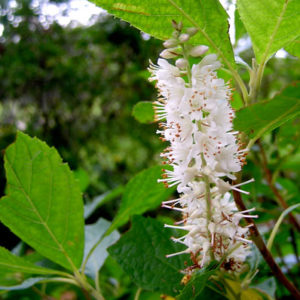 |
| Clethra alnifolia |
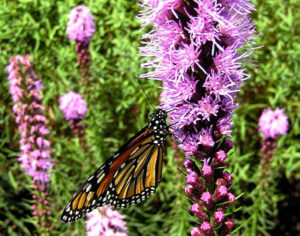 |
| Liatris and a Monarch butterfly |
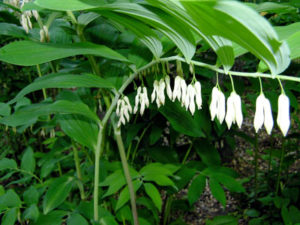 |
| Solomon’s seal (Polygonatum biflorum) |
By Heather McCargo
Photos by Jean English
Native plant corridors attract pollinators and wildlife to your farm by stretching across your property to connect your piece of native habitat to nearby meadows, wetlands or woodlands. This creates a much larger area for native pollinators to forage, raise young and migrate. Corridors may run along a road, between fields, in a swale or on the edge of a forest, connecting habitats off the property and returning native plants to the parts of the farm not suitable for traditional crops.
This article describes two approaches to creating native habitat corridors: changing mowing habits to favor native species, and planting woody and herbaceous combinations to increase native plant diversity on the farm.
Populations of all native species are in decline across the state. Our human footprint is taking its toll on wild creatures, including pollinators such as bees and butterflies that are so important on the farm for crop pollination. Native plant species each share an evolutionary history with indigenous insects, birds, reptiles, mammals, bacteria and fungi. When native plants are gone, many of these creatures go too, leading to a collapse of ecosystem function. Farmers benefit from the services provided by a healthy ecosystem, such as groundwater recharge; clean surface streams and ponds; pollination; a diversity of birds, spiders and amphibians to eat many insects including crop pests; and beneficial soil fungi and bacteria. Fortunately, when native plants are reintroduced into a landscape, many of these other creatures return.
As farmers and landowners, we can bring native plants, and the attendant diversity, back into the Maine landscape in a way that works with a farmer’s busy schedule. Many native plants thrive in dry, wet and shady areas that are poor sites for traditional farm crops.
Mowing Regime to Create a Pollinator Corridor
The easiest way to promote a pollination corridor is by changing your mowing regime. Along with forest clear-cutting and urban sprawl, mowing habits impact insect pollinators, birds and other fauna tremendously. In New England, most landowners and municipalities mow their roadsides and fields in the middle of the growing season. For hay harvesting, this makes sense, since the hay crop is at its prime. However, this is not good timing for native plant flowering and seed ripening or for the myriad creatures that depend on this critical part of the native plant life cycle. Pollinating insects depend on these native plants for some parts of their life cycle; for instance larval Monarch butterflies eat only milkweed foliage. In the months of May to October, insect-based pollination is at its height, and a healthy nearby population of these pollinators on the farm promotes effective crop pollination.
An easy way to support the life cycle of these plants and pollinators is to delay mowing until the end of the season – late October or early November in Maine. In fact, many meadow areas need only be mown every few years to keep the forest from returning.
Native pollinators such as bees and butterflies need more than flower nectar to survive. For much of the year, they are either hidden in a nest or cocoon or are in a different stage of life (think caterpillar before turning into a butterfly). Pollinators need native plants to deposit their eggs, feed their larvae (many of which eat only native vegetation) and for overwintering habitat. Leaves, bark on trees and shrubs, dead woody twigs, dried stems, rotting logs, branches, and even bare, undisturbed sandy or gravelly ground are all important habitat. When you mow an area, much of this year-round habitat is removed. To provide important food and overwintering habitat for fauna all year, divide your corridor into mowing zones. Each year choose a section of the pollination corridor to be the overwintering habitat and leave it un-mown. The rest can be mowed at the end of the season after the flowers have gone to seed. This simple method of changing mowing habits will provide an effective, robust pollinator habitat.
Planting a Hedgerow of Shrubs and Wildflowers
The second method involves actively reintroducing native woody and perennial plants to create year-round habitat for many of our most important insect pollinators, birds and other creatures. These plants can be added to an area that is now lawn, is not mowed or is located on the shady side of a field that borders a woodland. Much of the work can be done in late fall and early spring when the ground is too wet for planting annual crops. Many of these native plants even produce a harvestable crop.
A couple of months to a year before you intend to plant, lay down cardboard or newspaper with a heavy layer of mulch on top. Mulch can be straw, spoiled hay, bark mulch, aged wood chips, leaves, seaweed or any organic matter that is available at little or no cost. In a few months, the grasses and other vegetation under the mulch should be smothered and decayed. This is an effective way to get a weed-free planting area without tilling the soil. A site mulched in late September can then be planted easily the following spring or even a year later.
Bare-root shrubs, trees and perennial species (see sources below) can be planted by slicing through the mulch with a spade. For directly seeding wildflowers, a strip of weed-free organic mulch (as is available from Coast of Maine products) makes a nice seedbed. This can be laid on top of the previous mulch before planting.
A more efficient method for seeding native shrubs and wildflowers is to plant the seeds into nursery beds or pots and transplant a year or two later. (See the bibliography for native seed propagation information). I recommend choosing a minimum of 10 species for your corridor to ensure a diversity of bloom times and vegetation options for the fauna. Note the bloom times to ensure plenty of nectar for pollinators throughout the season.
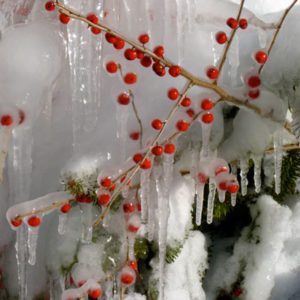 |
| Winterberry (Ilex verticillata) in winter |
The following native corridor species lists should provide plenty of choices for your pollinator corridor.
Plants for medium soil in part or full sun
Shrubs
Shadberry – Amelanchier canadensis, A. laevis
Chokeberry – Aronia arbutifolia, A. melanocarpa
Summersweet – Clethra alnifolia
Shrub dogwood – Cornus alternifolia, C. amomum, C. racemosa, C. sericea
Hazelnut – Corylus americana, C. cornuta
Hawthorn – Crataegus spp.
Shrubby St. John’s wort – Hypericum prolificum
Winterberry – Ilex verticillata
Cinquefoil – Potentilla fruticosa
Arborvitae – Thuja occidentalis
Viburnum – Viburnum dentatum, V. lentago, V. nudum, V. trilobum, V. prunifolium
Perennials
Canada anemone – Anemone canadensis
Indian potato – Apios americana
Aster – Doellingeria umbellata, Symphyotrichum novae-angliae
Wild geranium – Geranium maculatum
Pink butterflyweed – Aslepias incarnata
Milkweed – Asclepias syriaca
Blazingstar – Liatris ligulistylis
Penstemon – Penstemon digitalis
Black-eyed Susan – Rudbeckia hirta, R. triloba
Blue vervain – Verbena hastata
Golden Alexander – Zizia aurea
Plants for dry sandy or gravelly soil in part or full sun
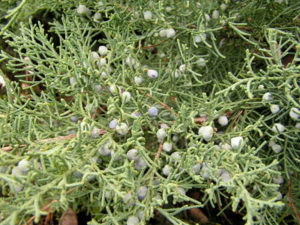 |
| Juniper berries |
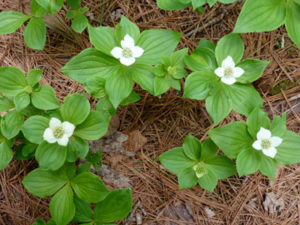 |
| Bunchberry (Cornus canadensis) in flower |
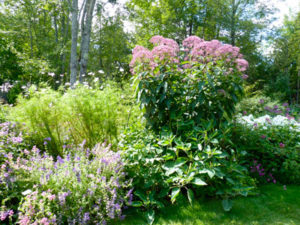 |
| Joe-pye weed (the tallest herbaceous plant pictured) |
Shrubs
Chokeberry – Aronia arbutifolia, A. melanocarpa
New Jersey tea – Ceanothus americanus
Gray dogwood – Cornus racemosa
Hazelnut – Corylus americana, C. cornuta
Yellow bush honeysuckle – Diervilla lonicera
Shrubby St. John’s wort – Hypericum prolificum
Juniper – Juniperus spp.
Bayberry – Myrica pensylvanica
Beach plum – Prunus maritima
Sumac – Rhus typhina
Wild rose – Rosa virginiana
Steeplebush – Spirea tomentosa
Viburnum – Viburnum nudum, V. prunifolium
Perennials
Butterfly weed – Aesclepias tuberosa
Field pussytoes – Antennaria neglecta
Aster – Aster concolor, A. ericoides
Wild strawberry – Fragaria virginiana
Liatris – Liatris squariosa
Lupine – Lupinus perennis
Black-eyed Susan – Rudbeckia hirta
Goldenrod – Solidago sempervirens
Plants for medium to dry and highly acidic soil in sun to part shade
Shrubs
Sweet fern – Comptonia peregrina
Huckleberry – Gaylussacia baccata
Bayberry – Myrica pensylvanica
Bush honeysuckle – Diervilla lonicera
Red elderberry – Sambucus pubens
Lowbush blueberry – Vaccinium angustifolium
Perennials
Bunchberry – Cornus canadensis
Lupine – Lupinus perennis
Violets – Viola pedata
Plants for wet soils in part or full sun
Shrubs
Buttonbush – Cephalanthus occidentalis
Summersweet – Clethra alnifolia
Dogwood – Cornus amomum, C. racemosa and C. sericea
Witch hazel – Hamamelis virginiana
Spicebush – Lindera benzoin
Winterberry – Ilex verticillata
Sweetgale – Myrica gale
Mountain holly – Nemopanthus mucronatus
Rhodora – Rhododendron canadense
Steeplebush – Spirea tomentosa
Pussy willow – Salix discolor
Elderberry – Sambucus canadensis
Highbush blueberry – Vaccinium corymbosum
Viburnum – Viburnum dentatum, V .nudum, V. trilobum
Perennials
Pink butterflyweed – Aesclepias incarnata
Marsh marigold – Caltha palustrus
Turtlehead – Chelone glabra
Joe-pye weed – Eutrochium maculatum, E. dubium, E. fistulosum
Boneset – Eupatorium perfoliatum
Blue flag iris – Iris versicolor
Lobelia – Lobelia cardinalis, L. siphilitica
Canada lily – Lilium canadensis
Golden ragweed – Packera aureus
Aster – Symphyotrichum novai-belgii
Blue vervain – Verbena hastata
Plants for a deciduous woodland corridor with part to full shade (planted on the north, east or west side of deciduous trees)
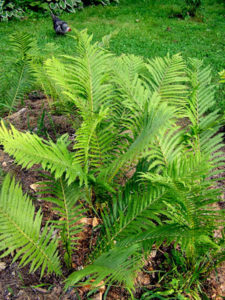 |
| Ostrich ferns (Matteuccia struthiopteris) |
Shrubs
Mountain maple – Acer spicatum
Pagoda dogwood – Cornus alternifolia
Witch hazel – Hamamelis virginiana
Spicebush – Lindera benzoin
Purple flowering raspberry – Rubus odoratus
Blueberry – Vaccinium spp.
Viburnum – Viburnum alnifolium, V. acerfolilum, V. dentatum, V. nudum
Perennials
Wild leek – Allium tricoccum
Wood asters – Eurybia macrophyllus, Symphyotrichum cordifolia
Blue cohosh – Caulophyllum thalictroides
Black cohosh – Cimicifuga racemosa
Goldenseal – Hydrastis canadensis
Ostrich fern – Matteuccia struthiopteris
Penstemon – Penstemon digitalis
Solomon’s seal – Polygonatum biflorum
False Solomon’s seal – Smilacena racemosa
Ginseng – Panax quinqefolia
Woodland goldenrod – Solidago caesia, S. flexicaulis
Wood violet – Viola novae angliae
Plants for part to full shade with conifers to the north, east or west side
Shrubs
Mountain maple – Acer spicatum
Yellow bush honeysuckle – Diervilla lonicera
Huckleberry – Gaylussacia baccata
Red elderberry – Sambucus pubens
Lowbush blueberry – Vaccinium angustifolium
Viburnum – Viburnum cassinoides
Perennials
Wood aster – Eurybia macrophylla, Symphyotrichum cordifolium
Canada mayflower – Maianthemum canadense
Bunchberry – Cornus canadensis
Wood sunflower – Helianthus divaricate
Woodland goldenrod – Solidago caesia, S. flexicaulis
Nursery Sources
Fedco Trees
Nasomi Farms: the nursery of the New England Wildflower Society
Native Haunts, Alfred, Maine https://www.nativehaunts.com
Prairie Moon Nursery
St. Lawrence Nursery
Wild Seed Project – seeds of Maine native plants www.wildseedproject.net
Bibliography
“Attracting Native Pollinators,” by the Xerces Society
“Bringing Nature Home,” by Douglas Tallamy
“Farming with Native Beneficial Insects,” by the Xerces Society
“Growing and Propagating Wildflowers,” by William Cullina
“Native Trees, Shrubs and Vines,” by William Cullina
New England Wildflower Society plant ID website https://gobotany.newenglandwild.org/simple/
About the author: Heather McCargo is executive director of Wild Seed Project, a 50(c)(3) nonprofit dedicated to returning native plants to the Maine landscape. From 1990-1995 she was the plant propagator at the New England Wildflower Society’s Garden in the Woods. She has written and lectured widely on native plant propagation and horticulture. Contact her at [email protected]. For further information, see www.wildseedproject.net.
